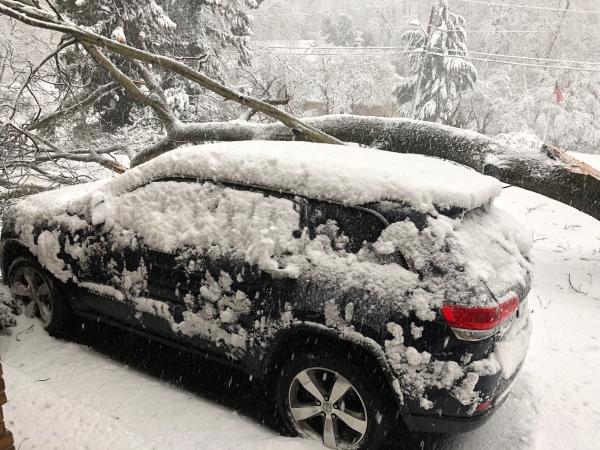
We all know the age-old philosophical classic, “If a tree falls in the woods and no one is around to hear it, does it make a sound?” Thanks to Snowmageddon currently preoccupying the Northeast, I can now definitively answer this question. YES! And, the sound is thunderous, loud and accompanied by profound shaking of the ground and your foundation. The act is startling, swift, precipitous and without warning. It mimics the feel of an earthquake.
That’s what I just experienced as a huge tree split in two down through its trunk and rapidly crashed on either side of my car entrapping it. Some parts went on to enter the living room shattering windows into the house.
What do you do when that happens?
First, you catch your breath and realize that you are incredibly fortunate because you just walked your dog right in that exact location. Then, it occurs to you that you need to bring your heart rate down to avert a heart attack by doing something useful and productive. Without power and an inability to go anywhere, you use your last bits of battery to write an article as a gentle reminder for all of us to be aware of the hazards such storms bring like this one presently paralyzing the Northeast. Often, it is these types of external causes like tree limbs falling that create dangerous conditions for people.
Though freak accidents can’t all be prevented, precautions can be taken to minimize bad consequences. Thankfully, numbers of such storm-related tree deaths are comparatively low, but unintentional injuries remain in the top 5 leading causes of death. According to the U.S. Centers for Disease Control and Prevention (CDC), 30.6 million emergency room visits each year are due to them along with 146,571 deaths. These numbers profoundly underestimate the overall health care burden since they don’t include those requiring medical attention either at the scene or through ambulatory services.
To learn more about why unintentional injuries have surged 23%, review Leonard Cohen’s Death by Falling Among Top 5 Leading Causes here.
The National Safety Council publishes an “Odds of Dying Chart” that affirms we are more likely in our lifetime to be killed by everyday activities - and they would like to prevent that, which is why they publish a probability of events. There is a 1 in 119 chance of dying from a fall compared to 1 in 62,288 from a cataclysmic storm, and a 1 in 102 chance of dying in a car as opposed to 1 in 114,195 chance from a lightning strike.
Though we often misplace fear on the things that never happen, we thereby risk worrying about the wrong things, unnecessarily escalating anxiety, underestimating actual concerns and adversely impacting our ability to live fully each day. Striking the balance is key to a life well-lived by arming yourself with the capacity to prevent avoidable injury without being preoccupied by it.
Measures to reduce distracted driving, employ more ideal prescription drug compliance and minimize misuse and abuse along with prioritizing ways to curtail falls can yield tremendous dividends for societal safety. These tangible, but fruitful endeavors will likely serve the majority of us more than emphasizing the 1 in 56,316 chance of dying by hot surface or substance or the 1 in 132,614 likelihood in a dog attack.
In summary
We don’t need a study to realize that being cognizant of our surroundings is a good idea. This is often impeded by our nonstop tether to our electronic devices, so maybe it is time to rethink that - not just for safety reasons, but to enhance real human connection which does wonders to quell social isolation.
Here are some easy methods to improve your odds:
-
Observe traffic laws (e.g. wearing a seat belt, following the speed limit, not being under the influence, tired, distracted or impaired)
-
Maintain your home environment (e.g. wipe spills, tuck away prominent cords, install handrails, bath mats, fix or remove problems, check carbon monoxide detectors & fire alarms, assess health of adjacent trees)
-
Only use your own prescription medications as prescribed by your physician
-
Use safety gear in sports and recreational activities (i.e. helmets, goggles)
-
Follow safety rules in the workplace
-
Make good choices with inclement weather (see here, here & here)
-
Learn to swim (see here)
-
Be careful with ladders, power tools and chemicals.
-
Learn CPR and first aid
-
Know your limits, in particular if you have an underlying illness or are at higher risk. Discuss and devise focused and effective plans with your doctor.
Lastly, we can all benefit from some luck. I know I am appreciative of it! Remember, taking no risks can also be a risk, so enjoy life and make sensible, informed decisions based on a healthy dose of properly directed - and not excessive - fear.



